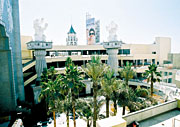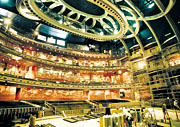
But some of that is going to change. A new landmark, the Hollywood and Highland development, is scheduled to open November 8, and the developer, TrizecHahn, is hoping that it will become one of the "must see" attractions in the area.
The $615 million development features an impressive lineup of major retailers, restaurants, and a collection of luxury stores, as well as a six-screen multiplex cinema and a hotel. The crown jewel in the development is the Kodak Theatre, which will host the annual Academy Awards(r) ceremonies beginning next year.
All of these wonderful amenities were shoehorned into the limited space that's available in this pricey part of town. That meant some headaches for those trying to figure out how to get all the heating and cooling equipment and associated ductwork into the tight space.
Big Spaces to Cool
The entire Hollywood and Highland complex is approximately 2 million sq ft. About 1.2 million sq ft of that total number consists of a 6-story underground parking garage. The Kodak Theater is around 90,000 sq ft, and there's approximately 600,000 sq ft devoted to retail space. The grand ballroom claims around 25,000 sq ft, and the six-screen cinema takes up about 40,000 sq ft.That's a pretty big space that needs to be heated and cooled, but it really wasn't that different than other projects, says Vic Markarian, senior project manager for ACCO Air Conditioning Company (Hollywood) the hvac contractor on the project. "There's really nothing unique or special about it. It's just a typical theater or retail complex of cinemas or ballrooms."
Many different types of hvac systems were discussed for the project, including water-source heat pumps and separate air-cooled systems. But given that the main criteria for the system were flexibility, efficiency, and overall cost, a central chilled water plant came out the winner. This is despite the fact that the other types of systems were a little bit less expensive.
Another consideration was the Renaissance Hollywood Hotel, operated by Marriott International, which will need to have its 640 rooms on 22 floors cooled as well. The hotel is an adjoining piece of the complex, and the central chilled water plant will supply it as well.
The central plant houses three York water-cooled centrifugal chillers - one 600-ton chiller and two 1,800-ton chillers. "We did not know what kind of tenants they were going to have at the time, even though it was planned for 40% to 45% for restaurant use, as well as recording studios and television stations broadcasting from there. We decided to put in about 25% to 30% redundancy and now that the leasing is coming in, we find that it was a good thing we put it in, because a lot of people are utilizing a lot more electricity than they're permitted to do," notes Markarian.
The central chilled water plant was sold to Sempra Energy Group, which will be selling the complex its energy. The company will also handle the maintenance and operation of the plant.
The retail tenants will have to supply their own individual fan-coil units or air-handling units (AHUs).
The ballroom has two large AHUs and utilizes a multizone variable-air volume (vav) system. "This has its advantages, because the ballroom can be broken up into five sections, and it's set up for television broadcast and various programs," says Markarian.
Humidity was also a concern, because the theater has cherry wood finishing inside, which can become damaged if there's too much humidity. For this reason, the central chiller plant began running in July to keep the wood from deteriorating. "Obviously we're keeping track of the outside and indoor air temperatures. We never had any problems with the humidity dropping below acceptable levels," says Markarian.
The 1.1 million-sq-ft underground parking structure has what is called a "push-pull" system, where outside air is brought in under positive pressure and is exhausted as required. The fans are triggered by carbon monoxide sensors.

Heat and Other Considerations
Given that Southern California is generally pretty warm, there will most likely be little need for space heating. In addition, there will be a large lighting load in most of the spaces. That's why it was determined there was no need for a central boiler plant. Instead, the various spaces will rely on individual rooftop boilers. For example, the ballroom has its own 1.7-MMBtu gas-fired boiler. Another boiler of the same size will be used only by Wolfgang Puck's kitchen, which will serve the ballroom.The theater will rely on two boilers, also about 1.7 MMBtu each. These feed the approximately 16 AHUs in the 3,600-seat theater. The retail areas will rely on electric heating.
As for ventilation, "We have ventilation requirements for 3,600 people plus the stage area. It's a fixed amount of ventilation, because we need the pressurization in the space. We have so much air going in, to the tune of 3 or 4 cfm per sq ft, so that's quite a bit of air going in there. We also put in CO2 sensors for outside air," says Markarian.
With all that ventilation, sound becomes an issue as well, because background noise could cause major problems for the various broadcasts that will take place from the complex. It was necessary to make sure the systems that were installed were not going to pose noise problems. Markarian notes that they've been working at a noise reduction coefficient (NRC) level of 20.
An "Invensys" building management system will ensure that all spaces are kept comfortable.
Problems Arise
One of the biggest issues concerning the Hollywood and Highland project was space, which was very limited for equipment, ductwork, and piping. "The initial thinking was to use a double-T system for support of the floor, and that in itself created limited clearances. On top of that, when the theater came along and went on top of this parking structure, the structural engineer had to put in a lot of heavy beams. The most critical parts were access and height clearances," says Markarian.In certain areas - particularly true in many of the equipment rooms - there is only a 1-in. clearance space. Markarian notes that they had to custom build isolation exhaust and supply fans because of the height limitations.
Another issue was adhering to California's strict building codes, particularly Title 24, California's Energy Efficiency Standards for Residential and Nonresidential Buildings. As Markarian notes, "We have special requirements here that would scare a horse." (Sidebar.)
The project also incurred the usual problems associated with changes and additions made by various parties involved in the project. But then another curve was thrown at the project when it was decided that the building would be classified as a high rise (it was originally classified a low-rise building, which uses a different building standard). That caused the fire marshal to become involved to ensure there was a smoke evacuation system plan and a fire exit plan.
When all is said and done, it was a good project, notes Markarian. "I'm worn out, though. But it is a nice project, and I think anybody would be happy to have worked on a project of this size." ES
More on Title 24
The Energy Efficiency Standards for Residential and Nonresidential Buildings were established in 1978 in response to a state mandate to reduce California’s energy demand. Since its establishment, the standards (along with standards for energy efficient appliances) have helped Californians save more than $15.8 billion in electricity and natural gas costs. It is estimated that an additional $43 billion will be saved by 2011.The standards are updated periodically to allow consideration and possible incorporation of new energy efficiency technologies and methods. The 1998 Standards, which are located online now, have an effective date of July 1, 1999. The Standard can be found at http://www.energy.ca.gov/title24/index.html.
But hold onto your seats, because the standard is 191 pages long, and that’s not including the various appendices and supplements that are also required.

